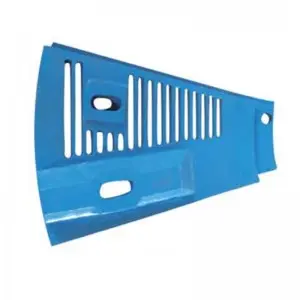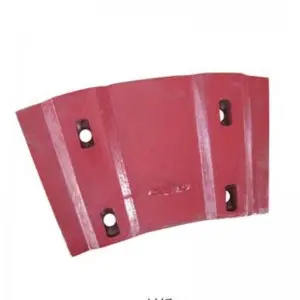When choosing the appropriate grinding mill liner, it is necessary to combine the specification parameters of the grinding mill (diameter, length, number of compartments) and the model characteristics (such as grate type, overflow type, rod mill, etc.), and match the size, structural strength and installation method of the liner. The following starts from the core parameters of the mill and elaborates on the selection logic of the liner and provides examples for reference:
Match the size of the liner plate according to the diameter and length of the mill
The diameter of the mill directly determines the radial dimension and impact strength of the liner.
Small mills (diameter < 2.4m) : Such as laboratory ball mills or small mineral processing equipment, the weight of a single liner should be controlled within 15kg, with a thickness of 15-25mm. A full-circle arc-shaped design (the arc is consistent with the inner diameter of the mill) should be adopted to reduce seams and avoid material sticking. For instance, in a φ1.8×3m ball mill, the liner is made of 20mm thick high-chromium cast iron. Each ring consists of 4 pieces and is directly fixed by bolts, making it suitable for processing small-scale materials (such as ceramic raw materials).
Medium-sized mills (diameter 2.4-4.2m) : Such as raw material mills in cement production lines, the thickness of the liner is 30-40mm, and the weight of each piece is 25-40kg. They adopt a wedge-shaped lap structure (with adjacent liners overlapping by 5-10mm) to enhance overall stability. The lining plate of the coarse grinding chamber of the φ3.2×13m ball mill is made of 40mm thick high manganese steel, which takes advantage of its toughness to resist the impact of large steel balls (φ100mm), while the fine grinding chamber is made of 30mm thick high chromium cast iron to enhance wear resistance.
Large grinding mills (diameter > 4.2m) : such as φ5×15m mining ball mills, the liners need to be modularly designed, with a single piece weight of no more than 50kg (convenient for manual installation), a thickness of 40-50mm, and adopt a “steel back + wear-resistant layer” composite structure (base material Q345 steel, surface surfacing with tungsten carbide). The number of blocks is calculated by diameter (8 to 10 blocks per meter of diameter) to ensure uniform force distribution. For instance, a φ5m mill is divided into 40 blocks per ring and rigidly connected to the cylinder through countersunk bolts, capable of withstands impact energy of over 1000J.
The length of the mill affects the axial layout of the liner. For long grinding mills (length > 10m), separate compartments should be designed for liners: high impact toughness liners should be used in the front compartment (coarse grinding section), and high wear resistance liners should be used in the rear compartment (fine grinding section). For instance, in a φ4×12m cement mill, the first 3m is lined with wavy high manganese steel plates, and the last 9m is lined with stepped high chromium cast iron plates, which is suitable for the entire process requirements of clinker from coarse grinding to fine grinding.
Select the liner structure according to the number of mill chambers and their functions
The functional positioning of the liners in single-chamber mills and multi-chamber mills is significantly different.
Single-chamber mill: For instance, a small rod mill (φ1.5×5m), the liner needs to be suitable for both coarse grinding and fine grinding. It adopts a smooth curved surface design (lifting bar height 50-60mm) to guide the grinding medium (steel rod) to perform a “rolling – grinding” movement, avoiding excessive local crushing. The material of the liner plate is selected as a bimetallic composite plate (with Mn13 as the base layer and Cr20 as the surface layer), suitable for grinding materials with full particle size ranging from 50mm to -200 mesh.
Double-chamber mill: The front chamber (coarse grinding) requires strong impact crushing. The liner plate should be of high convex edge wavy shape (lifting bar height 80-100mm), and the material should be high manganese steel (Mn18), with φ80-120mm steel balls. The rear chamber (fine grinding) focuses on extrusion grinding, using low convex edge stepped type (lifting bar height 40-60mm), with high-chromium cast iron (Cr26) as the material, and is matched with φ30-60mm steel balls. The φ3.6×6.4m double-chamber ball mill of a certain copper mine adopted this scheme, which increased the grinding efficiency of copper concentrate by 18%.
For three-chamber and above mills: such as cement mills (φ4.2×13m), the third chamber requires ultra-fine grinding. The liner plate should be a flat structure with fine grooves (groove depth 1-2mm), and the material should be selected as ceramic or rubber, combined with φ10-20mm steel segments, to control the specific surface area of the finished cement product to be ≥350m²/kg.
The liner design should be adapted to the characteristics of the mill model
The differences in working principles among different models of grinding mills determine the special design of the liners.
Grate type ball mill: The grate plate at the discharge end needs to be coordinated with the liner. The liner adopts “forward-inclined lifting strips” (with an Angle of 10° to the axis) to accelerate the movement of materials towards the grate plate and avoid overgrinding. For instance, in a φ2.7×3.6m grate type ball mill, the liner is made of 35mm thick high manganese steel, and the lifting bar is inclined forward by 10°. Combined with the 10mm discharge holes of the grate plate, the discharge efficiency is increased by 20%.
Overflow type ball mill: No forced discharge device. The liner needs to control the material flow rate. A “backward-inclined lifting strip” (with an Angle of 5°) is adopted to extend the grinding time. The liner of the φ3.2×4.5m overflow type mill is made of 40mm thick high-chromium cast iron. The backward-inclined lifting strips, in combination with a smooth surface, extend the residence time of gold ore powder in the machine from 15 minutes to 20 minutes, and increase the proportion of -325 mesh particles from 70% to 85%.
Rod mill: The grinding medium is steel rods. The liner plate should avoid the skewing of the steel rods. It adopts “straight surface + low lifting bar” (height 30-40mm), and the material is selected as 20mm thick medium carbon alloy steel (45Mn2), with surface quenching treatment (HRC40-45), which is both wear-resistant and reduces the wear on the steel rods. After a certain limestone rod mill adopted this design, the consumption of steel rods was reduced from 1.2kg/t to 0.8kg/t.
Match the wear resistance strength of the liner plate according to the rotational speed of the mill
The rotational speed of the mill (critical speed percentage) determines the motion state of the grinding medium, and thereby affects the force type of the liner.
Low-speed mill (speed < 70% critical speed) : The grinding medium mainly moves in a "falling" manner (mainly relying on friction grinding), and the liner needs to have high wear resistance. The material is preferred to be high-chromium cast iron (Cr15Mo3), and the surface is enhanced with fine texture (groove depth 0.5-1mm) to increase the coefficient of friction. For instance, in a φ3×9m cement mill (with a rotational speed of 18r/min), the wear rate of the liner can be controlled at 0.02mm/hour.
Medium-speed mill (70%-85% critical speed) : The medium moves in a "tossing" manner (impact + friction). The liner needs to balance toughness and wear resistance. A bimetallic composite liner (Mn13 base material + Cr20 surfacing layer) is selected, and the surface is designed with a wavy shape (wave height 15-20mm). After the φ4×6m copper mine ball mill (with a rotational speed of 22r/min) adopts this liner, it can not only resist the impact of steel balls but also reduce the wear of abrasive particles, with a service life of up to 1200 hours.
High-speed mill (> 85% critical speed) : The medium moves in a “centrifugal” state (mainly with strong impact), and the liner plate must have extremely high toughness. High manganese steel (Mn13Cr2) must be selected, with the thickness increased to 50mm. The root of the lifting bar is rounded (R=10mm) to avoid stress fracture. For instance, in a φ2.4×4m high-efficiency ball mill (with a rotational speed of 28r/min), the liner, after being hardened by high-frequency impact, has a surface hardness of HB500 and can withstand an impact stress of 200MPa.
Exclusive design according to model to meet special requirements
Some customized models of grinding mills require special liners. For example:
Wet grate type ball mill (such as φ5.5×8.5m) : Due to slurry corrosion, the liner needs to undergo anti-corrosion treatment. The surface of high manganese steel is sprayed with a 3mm thick ceramic coating (Al₂O₃), and the bolts are made of 316 stainless steel to prevent loosening caused by rust.
Dry air flow classification mill: The liner plate should be anti-static (surface resistance < 10⁹Ω), made of composite rubber (with carbon black conductive particles added), with a thickness of 20mm, and a smooth surface to reduce dust adsorption. It is suitable for grinding flammable materials such as coal powder and graphite.
Vertical ball mill: Its liners are distributed in a ring shape and need to withstand radial extrusion stress. 40mm thick wear-resistant cast iron (KmTBCr20Mo) is selected, and mortise and tenon structures are used at the joints to enhance the integrity, adapting to the axial pressure of vertical grinding.
Summary: The specifications of the mill determine the size and structural strength of the liner, the model characteristics determine the functional design of the liner, and the rotational speed affects the balance between the wear resistance and toughness of the material. For instance, when selecting liners for a φ5×15m overflow type ball mill, it is necessary to match 50mm thick bimetallic composite plates (suitable for diameter), backward-inclined lifting strips (suitable for overflow type), and wavy surfaces (suitable for medium speed) to achieve efficient and stable operation. International purchasers need to recommend suitable liners based on the parameters of the mill provided by the customer (diameter, rotational speed, model), in combination with the above logic, and at the same time provide installation guidance (such as bolt preload, block layout) to ensure a perfect match between the liner and the mill.


Post time: Jul-21-2025
